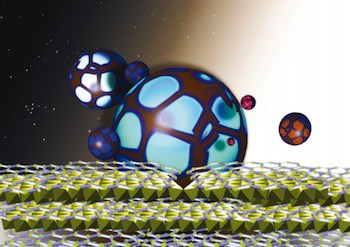
A review written by a group at the National Institute for Materials Science, Ibaraki, Japan, and published in nature.com’s Polymer Journal introduces the concept of “nanoarchitectonics” and explores why nanotechnology is not just an extension of microtechnology “What are the emerging concepts and challenges in NANO? Nanoarchitectonics, hand-operating nanotechnology and mechanobiology” [abstract]:
Most of us may mistakenly believe that sciences within the nano regime are a simple extension of what is observed in micrometer regions. We may be misled to think that nanotechnology is merely a far advanced version of microtechnology. These thoughts are basically wrong. For true developments in nanosciences and related engineering outputs, a simple transformation of technology concepts from micro to nano may not be perfect. A novel concept, nanoarchitectonics, has emerged in conjunction with well-known nanotechnology. In the first part of this review, the concept and examples of nanoarchitectonics will be introduced. In the concept of nanoarchitectonics, materials are architected through controlled harmonized interactions to create unexpected functions. The second emerging concept is to control nano-functions by easy macroscopic mechanical actions. To utilize sophisticated forefront science in daily life, high-tech-driven strategies must be replaced by low-tech-driven strategies. As a required novel concept, hand-operation nanotechnology can control nano and molecular systems through incredibly easy action. Hand-motion-like macroscopic mechanical motions will be described in this review as the second emerging concept. These concepts are related bio-processes that create the third emerging concept, mechanobiology and related mechano-control of bio-functions. According to this story flow, we provide some incredible recent examples such as atom-level switches, operation of molecular machines by hand-like easy motions, and mechanical control of cell fate. To promote and activate science and technology based on these emerging concepts in nanotechnology, the contribution and participation of polymer scientists are crucial. We hope that some readers would have interests within what we describe.
The authors introduce the concept of nanoarchitectonics with the observation that working in the nanoscale introduces difficult-to-control factors like thermal and statistical fluctuation, mutual interactions with surrounding components, and quantum effects. Nanoarchitectonics thus requires harmonizing various effects not encountered in microscale design. Strategies include fabrication by organizing nanoscale building blocks, even if unreliable, and organizing functions on the basis of mutual interactions. Early examples include atomic switches based on manipulation of atoms across small gaps, which, unlike conventional physical switches, can be modified to mimic the behavior of synapses. Collective responses to stimulus inputs may represent self-organized devices unexpectedly creating higher functions.
Another example is the automatic regulation of material releases from silica capsules with hierarchic pore architectures in which submicron-scale empty reservoirs are surrounded by silica walls with nanostructured pore channels, assembled layer-by-layer from silicon nanoparticles and polyelectrolytes. Even without external stimuli, water is released in a stepwise ON-OFF cycles from non-equilibrated evaporation from nanoscale pore channels and capillary movement from the nanoscale pores into the central reservoir.
The second emerging concept the authors introduce is “hand-operating nanotechnology” in which molecular machines are controlled by macroscopic mechanical action, based upon interfacial supramolecular chemistry. The authors cite examples in which efficiency of molecular recognition is increased at interfaces, noting improvements in molecular recognition through changing the interfacial environment. Molecular assembly in the confined spaces of interfaces restricts material diffusion and molecular motion, resulting in highly oriented structures with nano- and molecular-scale precision. At interfaces, macroscopic actions in the xy plane can be connected with nano/molecular functions in the z dimension. Thus it becomes possible that nanotechnological functions could be controlled by actions like hand motions.
One example is provided by the steroid cyclophane embedded at an air-water interface. This molecular machine has a central ring that converts from an open ring to a closed cavity upon high-pressure lateral compression, corresponding to a shift in the molecular area at the air-water interface from 7 to 2 nm2. This change can be correlated with the capture of a guest molecule.
The third emerging concept the authors present is mechanobiology and mechanical access to biological function. Mechanobiology examines how biomolecules, cells and tissues respond to mechanical stresses, measurement of mechanical parameters in biological systems, and developing mechanical control of biological activities. Envisioning mechanobiology as an outgrowth of nanoarchitectonics and interfacial mechanical control, the authors see it providing an attractive target for materials research: the development of mechano-structural stimulo-responsive polymeric materials for cell fate control. For example, they cite a hydrogel that becomes much softer on UV irradiation, thus modulating the stiffness of the extracellular matrix, thus modulating the behavior of cells in culture. Another example involves determining the differentiation and lineage specification of stem cells through the elasticity of the microenvironment.
This review presents an interesting roadmap into one developing sector of nanotechnology. It will be interesting to see what polymer chemists can contribute to the current stew of DNA nanotechnology, protein design, synthetic organic chemistry, surface science, etc.
—James Lewis, PhD

